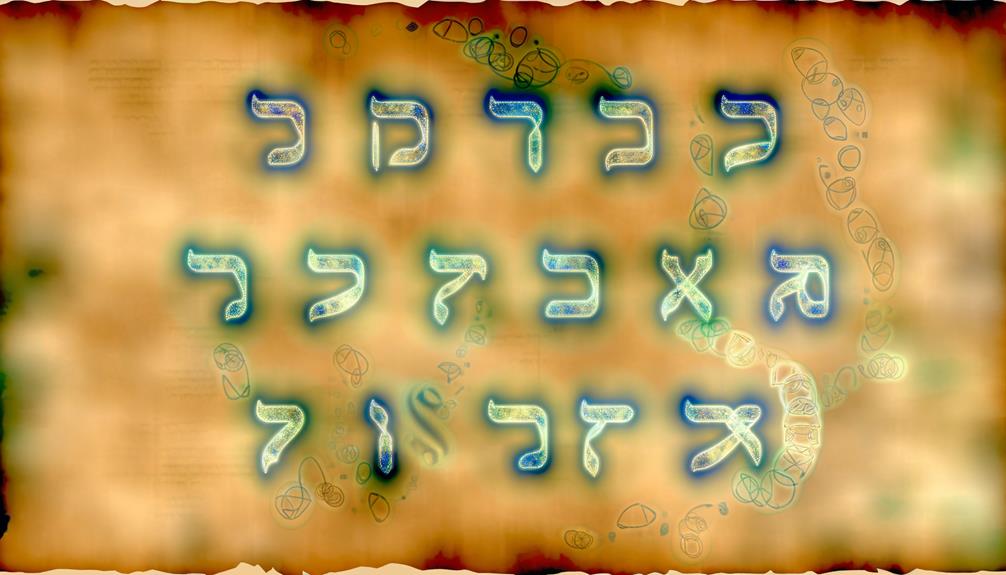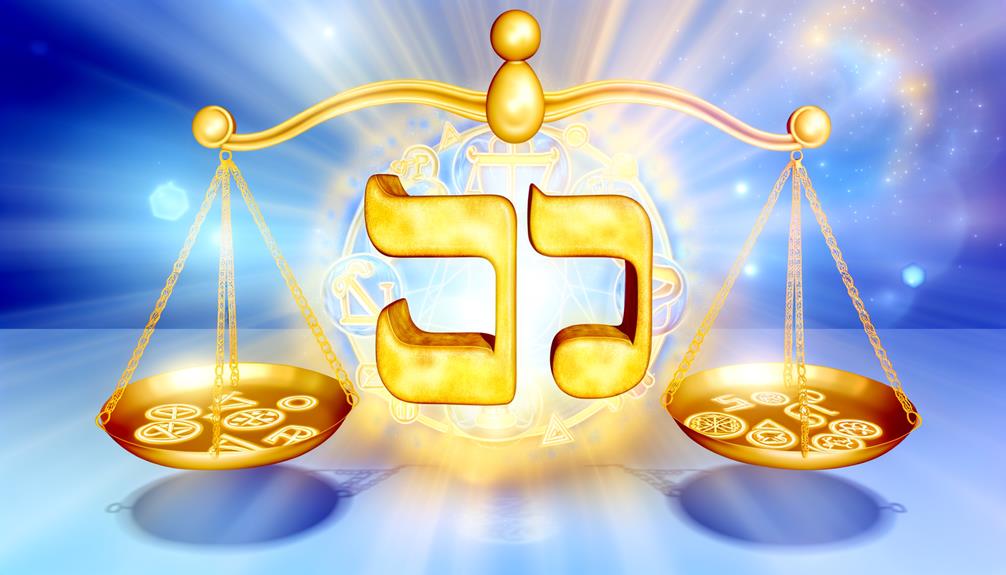Holy Bible Meaning of Letters: Divine Symbolism!
The letters of the Holy Bible, encompassing Hebrew, Aramaic, and Greek alphabets, bear profound symbolic, numerical, and theological significance integral to scriptural interpretation. For instance, in Hebrew, Aleph symbolizes the beginning and unity, while Bet signifies house and family.
Aramaic letters, like Aleph and Beth, reflect divine oneness and shelter. Greek letters hold similar importance, with Alpha representing origin and Omega denoting completion.
Each letter reveals layers of historical, cultural, and religious meaning, enhancing our understanding of divine communication and spiritual principles. Exploring these alphabets offers a deeper grasp of the Scriptures’ rich and nuanced insights.

Key Takeaways
- Aleph signifies the beginning and unity, representing God’s omnipresence and the inception of creation.
- Bet symbolizes a house, highlighting the nurturing environment and dwelling place of God among His people.
- Gimel represents reward and punishment, reflecting divine justice and the moral consequences of actions.
- Dalet symbolizes a doorway to higher spirituality, emphasizing humility and openness to divine wisdom.
Holy Bible Meaning of Letters – Symbolism and Significance
| Letter | Alphabet | Meaning/Significance | Scripture Reference |
|---|---|---|---|
| Aleph (א) | Hebrew | Represents God’s oneness and the beginning | Psalm 119:1-2, Genesis 1:1 |
| Beth (ב) | Hebrew | Symbolizes house, dwelling, God’s presence | Psalm 119:9-10, Genesis 28:17 |
| Gamma (Γ) | Greek | Represents the Trinity | Matthew 28:19 |
| Delta (Δ) | Greek | Symbolizes change or transformation | John 3:3 |
| Tav (ת) | Hebrew | Symbol of truth and covenant | Ezekiel 9:4, Revelation 22:13 |
| Alpha (Α) | Greek | Represents the beginning | Revelation 1:8 |
| Omega (Ω) | Greek | Symbolizes the end and completion | Revelation 22:13 |
Hebrew Alphabet Overview

The Hebrew alphabet, consisting of 22 consonantal letters, forms the foundational linguistic structure of the Old Scriptures, each character imbued with historical and theological significance.
Originating from ancient Semitic scripts, these letters are more than mere phonetic symbols; they encapsulate profound meanings and spiritual insights.
Each character, from Aleph to Tav, holds a unique position and numerical value, contributing to the rich tapestry of Hebrew poetry, law, and prophecy.
The alphabet’s abjad nature, lacking vowels, necessitates interpretive precision, underscoring the meticulousness required in scriptural exegesis.
This consonantal framework provides a lens through which scholars examine divine communication, revealing layers of meaning that transcend mere text to embody the spiritual essence of the Hebrew faith. By analyzing the roots and structures of Hebrew words, researchers uncover the intricate relationships between concepts that have shaped the spiritual landscape of Judaism for centuries. Each consonant and its corresponding vowel point not only form a word but also convey a deeper, holy meaning in the Bible that resonates with believers. Thus, the study of this framework allows for a richer understanding of scripture and a more profound connection to the divine.
Aleph: The Beginning

Aleph, the first letter of the Hebrew alphabet, embodies profound symbolism, representing the inception of all creation and the unifying principle underlying existence.
Its spiritual significance is rooted in its numerical value of one, denoting the singularity and omnipresence of God in monotheistic belief systems.
The form of Aleph itself, comprised of a diagonal vav and two yods, further elucidates the interconnectedness of the divine and earthly domains.
Symbolism of Aleph
As the first letter of the Hebrew alphabet, Aleph carries profound symbolic significance, representing concepts of origin, unity, and the divine. It is a silent letter, embodying the ineffable nature of God. Aleph is constructed of two Yods and a diagonal Vav, symbolizing the higher and lower waters connected by the divine spark. This structure reflects the intersection of the heavenly and earthly domains, underscoring the omnipresence of the divine in creation.
| Symbol | Element | Meaning |
|---|---|---|
| Yod | Upper | Divine spark, the heavens |
| Vav | Central | Connection, unity |
| Yod | Lower | Humanity, the earth |
| Aleph | Letter | Oneness of God |
| Aleph | Number | Numerical value of 1 |
Aleph, therefore, encapsulates the essence of beginning and unity.
Spiritual Significance Explained
In its role as the first letter of the Hebrew alphabet, Aleph serves as a profound symbol of beginnings, encapsulating the unity and divine origin inherent in creation.
The letter Aleph, often associated with the ineffable nature of God, underscores the concept of monotheism and the indivisible nature of the Divine. It is structurally composed of two Yods and a Vav, symbolizing the convergence of the spiritual and physical domains.
This configuration signifies the interconnectedness of heaven and earth, reinforcing the belief that all creation stems from a single divine source. Additionally, Aleph’s silent nature hints at the ineffable essence of God, transcending human comprehension.
Consequently, Aleph embodies the foundational principles upon which spiritual understanding is built.
Bet: House and Family

The Hebrew letter ‘Bet’ symbolizes the concept of a house and family, representing both the physical structure of a home and the nurturing environment it provides.
In biblical Hebrew, ‘Bet’ serves as the initial letter of the word ‘bayit’ (בית), meaning house. This dual significance extends beyond mere shelter to encompass familial bonds and communal relationships.
In a spiritual context, ‘Bet’ signifies the dwelling place of God among His people, as seen in the construction of the Tabernacle and Temple.
The letter’s form, resembling an open and enclosed space, further emphasizes inclusion and protection, highlighting the security and warmth a family offers.
Consequently, ‘Bet’ encapsulates both physical and spiritual dimensions of home life.
Gimel: Reward and Punishment

Gimel, the third letter of the Hebrew alphabet, symbolically embodies the concepts of reward and punishment within the biblical and mystical traditions.
In Hebrew, Gimel is derived from the root word ‘gamal,’ meaning to deal kindly or to repay, highlighting the dual aspects of divine justice.
Mystically, Gimel represents the benefactor who seeks out the recipient, mirroring the divine dispensing of grace and retribution.
This duality is reflected in various scriptural narratives where human actions are met with corresponding divine responses.
Such symbolism underscores the moral architecture of the universe in Judaic thought, where actions beget consequences.
Consequently, Gimel serves as a reminder of the ethical imperative to pursue righteousness, aligning human behavior with divine will.
Dalet: Doorway to Spirituality

Building upon the ethical principles highlighted by Gimel, the letter Dalet symbolizes a doorway to higher spiritual understanding and connection. In Hebrew, Dalet represents both a physical door and the concept of humility, inviting believers to reflect on openness and receptivity to divine wisdom. The Dalet, shaped like a door, encourages the journey from material to spiritual domains through faith and introspection.
| Concept | Symbolism | Significance |
|---|---|---|
| Dalet | Door | Represents change and opportunity |
| Humility | Receptivity | Emphasizes the need for humility to access spiritual truth |
| Physical Door | Passage | Symbolizes moving from the temporal to the eternal |
| Spiritual Journey | Transformation | Encourages personal growth and connection with the divine |
Dalet’s essence reflects the pivotal role of humility in spiritual evolution, serving as a critical conduit to deeper, more profound divine engagement.
Hey: God’s Presence

The Hebrew letter ‘Hey’ is intricately connected to the concept of God’s presence, symbolizing both a gateway to divine interaction and an embodiment of spiritual essence.
Its form and placement within scriptural contexts underscore a profound relationship between humanity and the divine, facilitating communication and connection on a metaphysical level.
This exploration of ‘Hey’ consequently illuminates its role in enabling believers to perceive and experience the omnipresence of God.
Symbolic Spiritual Connection
Encompassing profound theological significance, the Hebrew letter Hey (ה) symbolizes the presence of God, acting as a conduit for divine revelation and spiritual connection. This letter’s symbolic essence extends beyond its literal representation, embedding itself deeply within the spiritual fabric of biblical exegesis. Hey is often associated with divine breath, encapsulating the life-giving spirit of God.
Key symbolic connections include:
- Creation: Hey appears twice in the word for ‘to create’ (בָּרָא), signifying God’s creative power.
- Invocation: Used in prayers, Hey represents calling upon God’s presence.
- Transformation: Indicates spiritual transformation and renewal.
- Holiness: Symbolizes sanctity and the divine.
These connections underscore Hey’s integral role in spiritual discourse, enhancing our understanding of divine-human interaction.
Divine Communication Essence
Illuminating the intricate relationship between divine presence and human perception, the Hebrew letter Hey serves as a profound symbol of God’s communicative essence within the biblical narrative.
This letter, appearing in the tetragrammaton YHWH , signifies breath, revelation, and divine interaction.
Hey’s structure, open on one side, symbolizes the openness of God to impart wisdom and guidance.
In scriptural contexts, it embodies the moments of divine intervention and the manifestation of God’s will.
The letter Hey also represents the breath of life, reinforcing the concept of God as the ultimate source of existence and spiritual insight.
Consequently, Hey encapsulates the profound link between the sacred and the mortal, facilitating a deeper comprehension of divine communication.
Vav: Connection and Continuity

Symbolizing connection and continuity, the Hebrew letter Vav serves as a linguistic and conceptual bridge, linking ideas, events, and themes within the Holy Bible.
Vav, often translated as ‘and,’ intricately weaves together the narrative fabric of the scriptures, emphasizing unity and ongoing revelation. This connecting function is essential for understanding biblical texts as cohesive wholes rather than disjointed fragments.
- Narrative Flow: Guarantees smooth progression of biblical stories.
- Genealogies: Links generations, showing the continuity of God’s promises.
- Prophetic Writings: Connects prophecies with their fulfillments.
- Law and Covenant: Unifies legal codes and covenantal promises.
Vav’s role underscores the interconnectedness intrinsic to biblical interpretation.
Zayin: Spiritual Struggle

Rooted in the concept of conflict and perseverance, the Hebrew letter Zayin encapsulates the theme of spiritual struggle within the Holy Bible.
This letter, the seventh in the Hebrew alphabet, symbolizes both a weapon and nourishment, embodying the dual nature of spiritual battles.
In scriptural texts, Zayin often represents the struggle between good and evil, as well as the perseverance required to overcome adversity.
It signifies the internal and external conflicts faced by believers, urging them to wield spiritual strength and resilience.
The symbolic nature of Zayin invites an understanding of faith as an active engagement, where the believer must remain steadfast, armed with righteousness, to prevail in the face of spiritual challenges.
Aramaic Letters Significance

The Aramaic alphabet, originating in the late 10th century BCE, serves as a pivotal script in the historical and linguistic development of the Near East.
Each letter carries profound symbolic meanings, reflecting cultural, religious, and philosophical concepts integral to Aramaic-speaking communities.
Understanding these symbols provides invaluable insight into the interpretative layers of biblical texts and their theological implications. One prominent example is the star of Bethlehem, which is traditionally associated with the birth of Jesus in the biblical narrative. This symbol has been interpreted in various ways, ranging from a literal celestial event to a metaphor for spiritual guidance. The biblical interpretation of star symbols not only enriches our understanding of the text, but also offers deeper meaning and significance to the stories and teachings found in the Bible.
Aramaic Alphabet Origins
Emerging from the ancient civilizations of the Near East, the Aramaic alphabet not only served as a powerful tool for communication but also carried profound cultural and religious significance, deeply influencing subsequent writing systems, including Hebrew and Arabic.
This alphabet, consisting of 22 characters, was pivotal in the dissemination of religious texts and commercial records across vast regions. Its adoption and adaptation by various cultures underscore its versatility and enduring legacy.
Key points of influence include:
- Cultural Transmission: Facilitated the spread of Aramaic language and culture.
- Religious Texts: Integral in the transcription of significant religious documents.
- Linguistic Foundation: Served as the basis for several Semitic scripts.
- Trade and Commerce: Enabled efficient record-keeping and communication.
Symbolism in Aramaic Letters
Each letter of the Aramaic alphabet carries its own unique symbolism and meaning, profoundly influencing religious and cultural interpretations throughout history.
For instance, the letter Aleph symbolizes the oneness of God, representing both beginning and leadership.
Beth , signifying a house or dwelling, embodies concepts of shelter and divine presence.
Gimmel , often associated with a camel, denotes movement and blessing.
These letters were not mere phonetic symbols but were imbued with theological and philosophical significance.
Their intricate meanings extended into biblical texts, guiding exegesis and hermeneutics.
Understanding these symbols offers profound insights into ancient Aramaic culture and the spiritual dimensions embedded in their scriptural traditions.
Greek Alphabet Insights

Delving into the Greek alphabet reveals profound layers of meaning that have greatly influenced biblical texts and theological interpretations throughout history. Each letter carries not just phonetic significance but also symbolic and numerical connotations. This alphabet, integral to the New Covenant’s original composition, offers a rich tapestry of insights that deepen our understanding of scripture.
- Alpha (Α, α): Often symbolizes the beginning or origin, reflecting divine primacy.
- Omega (Ω, ω): Represents the end or completion, underscoring God’s eternal nature.
- Delta (Δ, δ): Signifies change or transformation, important in theological contexts.
- Theta (Θ, θ): Historically associated with death or the divine.
These nuanced meanings enrich biblical exegesis, offering deeper interpretative layers.
Conclusion
The exploration of the Hebrew, Aramaic, and Greek alphabets reveals a profound tapestry of spiritual and philosophical meanings woven into each letter.
The intricate interplay between language and theology offers more than mere symbols; it opens doorways to deeper understanding.
One cannot help but ponder: what further hidden wisdom lies in these ancient scripts, waiting to be unearthed?
The journey through these letters is just the beginning, hinting at untold depths of insight yet to be discovered.






